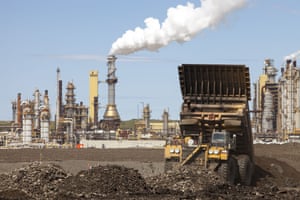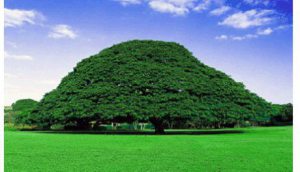Resource extraction responsible for half world’s carbon emissions, The Guardian March 12, 2019
Posted by OromianEconomist in Uncategorized.Tags: Economic growth, Environment, Environment & Natural Resources, Resource Management, The Guardian
3 comments
Extraction also causes 80% of biodiversity loss according to comprehensive UN study,
Jonathan Watts, The Guardian
‘However, they said this dire scenario could be avoided if there is a faster transition towards renewables, smarter urban planning to reduce the demand for concrete, dietary changes to lower the need for grazing pastures and cut levels of waste (currently a third of all food), and a greater focus on creating a cyclical economy that re-uses more materials. They also called for a switch of taxation policies away from income and towards carbon and resource extraction.’

Extraction industries are responsible for half the world’s carbon emissions and more than 80% of biodiversity loss, according to the most comprehensive environmental tally ever undertaken of mining and farming.
While this is crucial for food, fuel and minerals, the study by UN Environment warns the increasing material weight of the world’s economies is putting a more dangerous level of stress on the climate and natural life-support systems than previously thought.
Resources are being extracted from the planet three times faster than in 1970, even though the population has only doubled in that time, according to the Global Resources Outlook, which was released in Nairobi on Tuesday.
Each year, the world now consumes more than 92b tonnes of materials – biomass (mostly food), metals, fossil fuels and minerals – and this figure is growing at the rate of 3.2% per year.
Since 1970, extraction of of fossil fuels (coal, oil and gas) has increased from 6bn tonnes to 15bn tonnes, metals have risen by 2.7% per year, other minerals (particularly sand and gravel for concrete) have surged nearly fivefold from 9bn to 44bn tonnes, and biomass harvests have gone up from 9bn to 24bn tonnes.
Up until 2000, this was a huge boost to the global economy, but since then there has been a diminishing rate of return as resources become more expensive to extract and the environmental costs become harder to ignore.
“The global economy has focused on improvements in labour productivity at the cost of material and energy productivity. This was justifiable in a world where labour was the limiting factor of production. We have moved into a world where natural resources and environmental impacts have become the limiting factor of production and shifts are required to focus on resource productivity,” says the study.
The economic benefits and environmental costs are broken down by sector. Land use change – mostly for agriculture – accounts for over 80% of biodiversity loss and 85% of water stress as forests and swamps are cleared for cropland that needs irrigation. Extraction and primary processing of metals and other minerals is responsible for 20% of health impacts from air pollution and 26% of global carbon emissions.
The biggest surprise to the authors was the huge climate impact of pulling materials out of the ground and preparing them for use. All the sectors combined together accounted for 53% of the world’s carbon emissions – even before accounting for any fuel that is burned.
“I would never have expected that half of climate impacts can be attributed to resource extraction and processing,” said Stefanie Hellweg, one of the authors of the paper. “It showed how resources are hiding behind products. By focusing on them, their tremendous impact became apparent.”
The paper highlights growing inequalities. In rich countries, people consume an average of 9.8 tonnes of resources a year, the weight of two elephants. This is 13 times higher than low incomes groups. Much of this is unseen because huge amounts of materials are often needed for a small end product, such as a mobile phone.
Izabella Teixeira, former environment minister of Brazil, said the report highlighted how rich consumer nations have exported environmental to poor producing countries. With this model now hitting climate and biodiversity boundaries that affect everyone on the planet, she said it was time for change. “Currently decisions are being based on the past but we need to base them on the future. That means leadership.”
Where leadership could come from is difficult to see in the current political environment. The US and Brazil are slashing existing environmental regulations. China has moved ahead on renewables and pollution, but its growth is even more material-intensive than developed nations. According to the report, Asia is driving the fastest demand for minerals among upper-middle income countries, which now – because of their big populations – have a greater combined material weight than wealthy nations.
Concrete: the most destructive material on Earth
Read more
The authors said it was essential to decouple economic growth from material consumption. Without change, they said resource demand would more than double to 190bn tonnes per year, greenhouse gases would rise by 40% and demand for land would increase by 20%.
However, they said this dire scenario could be avoided if there is a faster transition towards renewables, smarter urban planning to reduce the demand for concrete, dietary changes to lower the need for grazing pastures and cut levels of waste (currently a third of all food), and a greater focus on creating a cyclical economy that re-uses more materials. They also called for a switch of taxation policies away from income and towards carbon and resource extraction.
“It is possible to grow in a different way with fewer side effects. This report is clear proof that it is possible and with higher growth,” said Janez Potočnik, co-chair of International Resource Panel and former environment commissioner for the European Union. “It’s not an easy job to do, but believe me the alternative is much worse.”
Ethiopia’s Governance And The Current Situation And Management of Natural Resources August 13, 2013
Posted by OromianEconomist in Uncategorized.Tags: Africa, Colonizing Structure, Development, Ethiopia, Governance issues, Natural resources, Oromia, Oromo, Resource Management
2 comments

“Despite the change of leadership following the death of Mr Meles last August, there are few signs of any shift away from the prevailing state-led development model. Nonetheless, it is possible that the government could be forced into a policy turnaround if it is unable to secure the financing required to support its ambitious and underfunded five-year economic plan. At present, the plan is largely financed by direct central bank financing and by forcing private banks to purchase Treasury bills (T-bills); however, this strategy is both inflationary and unsustainable.”
‘Ethiopia became a de facto one-party state following the May 2010 general election, which more or less wiped out the opposition, after years of determined progress. The ruling alliance has strengthened its grip on power through a steady erosion of political liberties, including the use of controversial anti-terrorism legislation. However, the death in August 2012 of Meles Zenawi—the long-standing prime minister, who did much to hold the ruling coalition together—has taken Ethiopia into uncharted territory. In line with the constitution, the former deputy prime minister and foreign minister, Hailemariam Desalegn, has been endorsed as prime minister following the death of Mr Meles. Nonetheless, if Mr Hailemariam fails to stamp his authority on the coalition, the risk of ethnic and religious tensions will increase. Ethiopia’s population was nearly 85m in 2011 according to World Bank estimates, making it SubSaharan Africa’s second-most populous nation after Nigeria. Its population grew by an average of 2.7% a year in 1990-2011, and is expected to reach 120m by 2025, according to projections by the UN. There are more than 80 different ethnic groups represented in the country. The population is still overwhelmingly rural, with only 17% living in towns. Economic progress—and, in turn, political stability—will be heavily dependent upon Ethiopia’s continued access to foreign aid. In this respect, the government has faced criticism for its hard-line response to any domestic opposition. Indeed, it seems likely that, for the foreseeable future, the regime will continue to protect its hegemony using restrictive legislation and periodic crackdowns by the security services. At the same time, as the largest country in the Horn of Africa, Ethiopia has positioned itself as a bulwark of Western states against Islamist terrorists in the region. This factor is likely to outweigh donor concerns about possible misuse of aid. The impasse with Eritrea over the two countries’ disputed border remains a significant political risk, although a return to all-out conflict (as occurred between 1998 and 2000) is not expected in the near future; Eritrea is unlikely to initiate any hostilities, since it would almost certainly lose, while the Ethiopian authorities are aware of the damage that renewed conflict would do to relations with, and funding from, international donors. The Ethiopian People’s Revolutionary Democratic Front (EPRDF)—an alliance of four main groups—won an overwhelming majority in parliament at the May 2010 election. Following the death of Mr Meles, the 180-member council of the EPRDF gave its unanimous—if belated—endorsement to his deputy, Mr Hailemariam. This suggests that the party wishes the latter to remain in the post, at least until the next elections, due in 2015. However, the longer-term prospects for EPRDF unity are more uncertain. Mr Hailemariam is currently attempting to rebalance the EPRDF—traditionally dominated by the Tigrayan People’s Liberation Front (TPLF).’
Ethiopia’s country profile by The Economist Intelligence Unit, 2013. To read the details on Ethiopia and other 24 African countries click the following links:
http://www.iag-agi.org/spip/The-African-Markets-Managing.html
Copyright © Oromianeconomist 2013 and Oromia Quarterly 1997-2013. All rights reserved. Disclaimer.



What are the key elements of social intelligence? Click here to read the full article by Ronald E Riggio Ph.D. Cutting-Edge Leadership
Read more at: https://www.skillsyouneed.com/ips/social-skills-emotional-intelligence.html
It’s no secret that good leaders are also good communicators. And the best leaders have learned that effective communication is as much about authenticity as the words they speak and write.
Indeed, communication and leadership are inextricably tied. How can you galvanize, inspire or guide others if you don’t communicate in a clear, credible, authentic way?
Here are 5 essential communication practices of effective leaders. Click here to read at Forbes the 5 Habits of Highly Effective Communicators: Mind the say-do gap. Make the complex simple. Find your own voice. Be visible. Listen with your eyes as well as your ears.
How to Spot a Bad Leader: Click here to learn the tactics used by leaders from hell.
Click here to read on 5 Steps to Great Leadership: How do our leaders measure up?